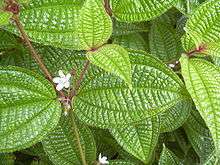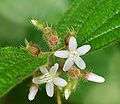Clidemia hirta
Clidemia hirta, commonly called soapbush or Koster's curse, is a perennial shrub. It is an invasive plant species in many tropical regions of the world, creating serious damage.
| Clidemia hirta | |
|---|---|
 | |
| Scientific classification | |
| Kingdom: | Plantae |
| Clade: | Tracheophytes |
| Clade: | Angiosperms |
| Clade: | Eudicots |
| Clade: | Rosids |
| Order: | Myrtales |
| Family: | Melastomataceae |
| Genus: | Clidemia |
| Species: | C. hirta |
| Binomial name | |
| Clidemia hirta | |
Physical description
Clidemia hirta is a densely branching long-lived (perennial) shrub normally growing 0.5-3 m tall, but sometimes reaching 5 m in height, depending on habitat. In more shaded habitats it grows much taller than it does in exposed areas, where it typically grows less than 1 m tall.
The younger stems are rounded and are covered in large, stiff, brown or reddish-colored hairs (they are strigose). The oppositely arranged simple leaves are borne on stalks. They are oval or egg-shaped in outline with broad end at base, with pointed tips, and almost entire to finely toothed margins. Their upper surfaces are sparsely covered in hairs, similar to those found on the stems, while their lower surfaces and margins are more densely hairy. The leaves also have a somewhat wrinkled appearance and five distinct veins that run in an almost parallel fashion from the leaf bases to their tips.
The flowers are arranged in small clusters at the tips of the branches. Each flower is borne on a very short stalk and has five white, or occasionally pale pinkish, petals. The base of the flower is swollen into a cup-shaped structure which is moderately to sparsely covered with a mixture of bristly and sticky hairs. The flowers also have five sepals, but these are very small, and five distinctive stamens that have a claw-like appearance.
The small, rounded fruit are berries and are either dark blue, purplish or blackish in color. Each of these berries contains over 100 light brown colored seeds. These fruit are also covered in stiff spreading hairs, especially when they are young.
In terms of economic uses, Clidemia hirta has been widely introduced as an ornamental plant. Ornamental plants are used for decorative purposes, such as gardens and houseplants.[1]
Distribution and habitat
Originally from the American Neotropics (Mexico to Paraguay as well as the Caribbean),[2][3] it has been introduced broadly across Southern Asia and East Africa, and occurs in two isolated areas within Australia.
It was introduced to Hawaii in the 1940s; by 1978 it had spread to over 90,000 acres (360 km2) of land on Oahu. In 1972 Koster's curse was first spotted on the Big Island. In Sri Lanka it is quite invasive in wet zone and upcountry forests, especially invading gaps in the forest, preventing other native species from emerging.[4] This species grows successfully in humid tropical climates and typically invades both disturbed and undisturbed habitats. It is a potential weed of wetter pastures, open grasslands, plantations, roadsides, wetter open woodlands, riparian zones (banks of watercourses), forest margins and rainforests.[5]
Biology and ecology
The plant grows 1–5 metres (3 ft 3 in–16 ft 5 in) tall, depending on habitat.
The purple-brown to blue-black berries are up to 8 millimetres (0.31 in) long and taste a bit like a deeply flavored blueberry. Each fruit contains more than 700 tiny (0.5 mm) seeds. It flowers and fruits all year, if conditions are moist enough. A large plant can produce more than 1,000 fruits in a single year for a total of 700,000 seeds. The seeds are dispersed by birds, feral pigs, other animals, and humans. Sheep will not eat the plant, and the tannin inside the fruits is poisonous to goats. Biosecurity trials in Australia show that the seeds can remain viable in the soil for at least 12 years.
The human edibility factor of this berry has not been fully explored. The tannin inside of the fruit is not harmful to humans and a delicious syrup may be made from the fruit. The syrup has a beautiful indigo blue color and may be used to enhance and remove the bitterness of teas such as yerba mate. Furthermore, the plant is used in Brazil to treat Leishmania braziliensis skin infections (Franca et al., 1996).[6]
Name
The epitheton hirta means "bristly" in Latin. "Koster's curse" is a commonly used name in places where the plant grows as a noxious weed, such as Hawaii. Koster was the man who between 1880 and 1886 accidentally introduced seeds of C. hirta to Fiji in coffee nursery stock, where its problematic nature was first noticed around 1920 (Paine, 1934; Simmonds, 1937). Originally only known as "the curse" for the damage it did to coconut plantations, its vernacular name became a model after which those of other invasive plants were patterned, such as Ellington's curse on Fiji, McConnel's curse in Australia, or Curse of India in East Africa.
As an invasive species
This species is native to much of tropical America, but is an invasive species in Southern Asia, East Africa, and some oceanic islands (like Hawaii and Australia) with warmer climates [7]. Koster's curse can form dense thickets that smother plantations, pastures and native vegetation. Disturbance is a key element in the establishment and invasion of Koster’s curse. Wildfires, landslides, windstorms and other forms of soil disturbance (such as pig rooting) accelerate the dominance of this weed (Smith Undated; Peters 2001). In its native environment plants are confined to open areas and only become dominant about twelve months after disturbance, such as in slash-and-burn agricultural areas (Burkhart Pers. Comm, in Smith Undated). All new range extensions in Hawaii begin along the open edges of trails or other disturbed areas [8]. In Hawaii, Koster’s curse is replacing the endemic species that formerly dominated the forests and threatens their extinction. Elsewhere, it is regarded as one of the most problematic invasive species in the Comoros Archipelago, on La Réunion, in the Seychelles and on Mauritius.[9]
Control strategies/biological control
In order to keep the weed out of an area the primary management objective should be to minimize and prevent disturbance (Smith Undated).[10]. Manually pulling plants out of the ground supplemented by herbicide application is an effective but temporary control method.[2] The thrips species Liothrips urichi from Trinidad is being used to biologically control C. hirta; it was first employed on Fiji in 1930 (Simmonds, 1933). Controlling feral pig populations (Sus scrofa) has been widely suggested as an effective means to reduce the spread of C. hirta, as ground disturbance by these exotic mammals is strongly linked to the successful establishment of C. hirta, as well as a number of other invasive plants such as Morella faya. Although sheep have been shown to control most weeds in plantations, they will not eat C. hirta (Francis, 2004).[11]. According to Mune and Parham (1967), no effective chemical control for C. hirta exists. However, Teoh et al. (1982) reports that C. hirta may be killed by applications of triclopyr. Norman and Trujillo (1995) have found that a mycoherbicide containing Colletotrichum gloeosporioides f.sp. clidemiae as the active ingredient was effective against C. hirta.[12].
Policy and law
Clidemia hirta has been nominated as among 100 of the "World's Worst" invaders by the IUCN Invasive Species Specialist Group and it has been listed as a noxious weed in Queensland and the Northern Territories (Australia) and Hawaii. It is not listed as a noxious weed by the state or governments in Kenya, Tanzania and Uganda.[13]
Occurrence in Australia
An infestation of Koster’s curse was found in Julatten (near Mount Molloy, Queensland) in 2001. This outbreak threatens to spread into the Mount Lewis National Park and Mowbray National Park. Community-based efforts to control Koster's curse in Julatten are coordinated by the.[14]
In 2016 a second infestation was discovered in Wooroonooran National Park.
Koster’s curse has the potential to spread rapidly over many areas of Australia where conditions are suitable, including the Northern Territory, northern New South Wales, and much of north-east Queensland.
In New South Wales Australia, there is a hotline number for citizens to call and report any noticed occurrences of the plant.[15]
Synonyms
Taxonomic synonyms for C. hirta include:
- Clidemia benthamiana
- Clidemia cognata
- Clidemia crenata
- Clidemia elegans (Aubl.) D. Don 1823[16]
- Clidemia leptocada
- Clidemia pauciflora
- Dancera hirta
- Leandra fimbriata
- Melastoma anhaga
- Melastoma aristatum
- Melastoma elegans
- Melastoma rustica
- Staphidium elegans
- Staphidium hostmanii
Gallery
 Clidemia hirta plant
Clidemia hirta plant Clidemia hirta fruits
Clidemia hirta fruits Clidemia hirta ripened fruits
Clidemia hirta ripened fruits Clidemia hirta
Clidemia hirta Clidemia hirta leaves, flowers and fruits
Clidemia hirta leaves, flowers and fruits
References
- BioNET-eafrinet, keys and fact sheets. Clidemia Hirsta (Koster’s Curse). Web.
- "Clidemia hirta" (PDF). International Institute of Tropical Forestry. United States Department of Agriculture. Retrieved 2009-02-18.
- "Clidemia hirta". Germplasm Resources Information Network (GRIN). Agricultural Research Service (ARS), United States Department of Agriculture (USDA). Retrieved 2009-02-18.
- Lalith Gunasekera, Invasive Plants: A guide to the identification of the most invasive plants of Sri Lanka, Colombo 2009, p. 95–96.
- BioNET-eafrinet, keys and fact sheets. Clidemia Hirsta (Koster’s Curse). Web. https://keys.lucidcentral.org/keys/v3/eafrinet/weeds/key/weeds/Media/Html/Clidemia_hirta_(Kosters_Curse).htm.
- CABI. “Koster’s Curse.” Datasheet.
- BioNET-eafrinet, keys and fact sheets. Clidemia Hirsta (Koster’s Curse). Web.
- Global Invasive Species Database. Clidemia hirta (shrub). Web. 2006.
- BioNET-eafrinet, keys and fact sheets. Clidemia Hirsta (Koster’s Curse). Web.
- Global Invasive Species Database. Clidemia hirta (shrub). Web. 2006.
- CABI. “Koster’s Curse.” Datasheet. https://www.cabi.org/isc/datasheet/13934.
- CABI. “Koster’s Curse.” Datasheet.
- BioNET-eafrinet, keys and fact sheets. Clidemia Hirsta (Koster’s Curse). Web.
- "Kosters curse Coordination Centre". Retrieved 2017-09-16.
- NSW WeedWise. 2018. Department of Primary Industries. “Koster’s curse.”
- D. Don Mem. Wern. Nat. Hist. Soc. 4: 309 1823
- Paine, R.W. (1934): The control of Koster's curse (Clidemia hirta) on Taveuni. Fiji Agricultural Journal 7(1): 10-21.
- Simmonds, H. W. (1933): Biological control of Clidemia hirta. Fiji Agricultural Journal, 6(2): 32–33.
- Simmonds, H. W. (1937): The biological control of the weed Clidemia hirta commonly known in Fiji as 'the curse'. Fiji Agricultural Journal, 8(3): 37–39.
External links
| Wikimedia Commons has media related to Clidemia hirta. |
- New World Fruits Database
- John K. Francis: Clidemia hirta (PDF file)
- Clidemia hirta information from the Hawaiian Ecosystems at Risk project (HEAR)
- Biosecurity Queensland Fact Sheet information (PDF File)